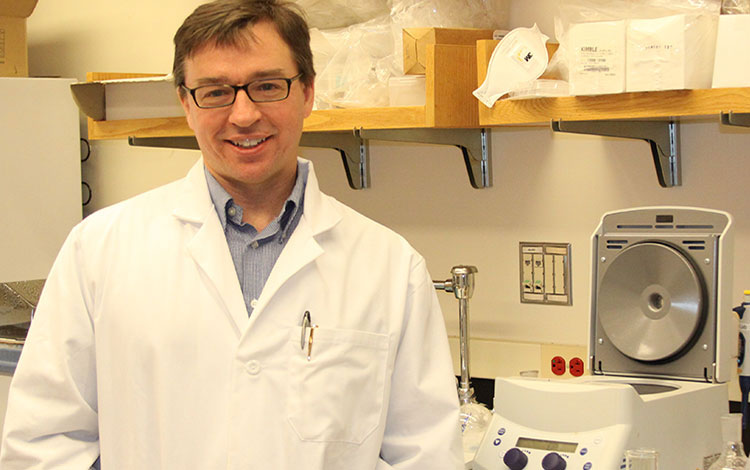SOP Faculty Receive $1.5 Million from the FDA to Study Iron Medications
Interdisciplinary group will research the effectiveness of brand versus generic iron medications used to treat anemia in kidney disease patients
By Becky Ceraul
February 24, 2015
Four faculty members from the Department of Pharmaceutical Sciences (PSC) at the University of Maryland School of Pharmacy have received a $1.5 million, three year grant from the United States Food and Drug Administration (FDA) that will enable them to study the differences between specific iron brand and generic medications given to kidney disease patients who suffer from anemia. The goal of the study is to determine the bioequivalency of the two iron medications because some concerns exist about differences in the safety of the brand and generic versions.
Sarah Michel, PhD, an associate professor in PSC, will lead the study, which includes an 18-month clinical trial with 48 healthy volunteers and research on the blood samples collected from the volunteers.
“Patients who suffer from chronic kidney disease tend to develop anemia that is often treated with IV injections of iron complexes or iron drugs,” she says. “There are both a brand name and a generic drug approved by the FDA to treat this anemia, but there is some concern following a study done in Europe about the potential toxic effects of the generic because of iron overload. Through our study, we hope to answer the question about whether or not the brand and generic drugs have the same effect when they are administered to patients. To do this, we will examine each drug’s formulation, how the drugs impact the distribution of iron in the plasma, and whether they produce iron overload, which can be detrimental to patients.”
Michel, who is a bioinorganic chemist (studies metal ions), has teamed with Maureen Kane, PhD, an assistant professor in PSC with expertise in mass spectrometry; James Polli, PhD, the Noxell/Shangraw Endowed Chair in Pharmaceutics within PSC who has expertise in bioequivalency studies and clinical trial design; and Angela Wilks, PhD, a professor in PSC who researches mechanisms by which bacterial pathogens acquire and utilize hemoglobin as an iron source. They will be joined by Tricia Ting, MD, an associate professor of neurology at the University of Maryland School of Medicine, who will serve as the study’s medical officer.
According to Michel, the iron from the drug is initially bound to a protein in the body called transferrin. When there is too much iron in the body (overload), it runs out of transferrin protein to bind to and the remaining iron floats free causing oxidative damage, which can result in a myriad of diseases ranging from inflammation to arthritis and cancer.
In order to evaluate the safety of the generic versus the brand iron medication in question and to understand the potential impact of iron overload, the research team will use various methods to analyze the blood samples collected from the study volunteers. “My lab’s expertise is in understanding metal ions like iron,” says Michel. “We will use inductively coupled plasma mass spectrometry coupled to high performance liquid chromatography to measure the total iron levels and identify the proteins that the iron is binding to in the samples we collect.”
Kane, who is co-director of the School’s Mass Spectrometry Center, will use instrumentation in the Center to measure biomarkers of oxidative damage that might occur as a result of iron overload while Wilks will use biochemical approaches to study other cellular markers of oxidative damage. The team will also examine the formulation of each drug to determine how their formulations may impact the distribution of iron in the plasma upon administration of the medication.
“The beauty of this study is the use of advanced chemical, biochemical, toxicologic, and nanoparticulate laboratory methods that Drs. Michel, Kane, and Wilks are developing to evaluate if the generic is as safe as the brand medication being tested,” says Polli, who will work with Ting on the clinical trial design. “In fact, scientists from prestigious institutions in Europe are visiting during the study to learn about these advanced methods and our study design.”
“This project has the potential to significantly improve the lives of patients who suffer from anemia as a result of chronic kidney disease,” says Andrew Coop, PhD, professor and chair of PSC. “Securing a grant of this nature from the FDA is a testament to the expertise of the department’s faculty who span the drug discovery and development spectrum, from biochemistry to clinical trials. I’m proud of the collaborative spirit that exists in our department and within the School of Pharmacy that makes it possible to translate basic science findings to clinical practice.”
“My hope for this study is that we identify benchmarks for how much of the generic versus the brand name drug to deliver to anemia patients and what the effects will be,” says Michel. “It might be a matter of changing the dosage or better monitoring the patient during treatment of the IV iron medication.”



